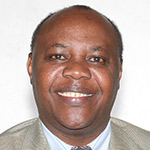Introducing James P. Mwangi, Ph.D., P.E., S.E. – our first annual Simpson Strong-Tie Engineering Excellence Fellow with Build Change. James Mwangi will write a quarterly blog about his experience throughout the Fellowship.
I’m delighted to have been asked to contribute this post and feel honored to be the first-ever Simpson Strong-Tie Engineering Excellence Fellow with Build Change. It’s my hope that this post will inform you about my professional background, why I applied to the Fellowship and how I think the Fellowship can benefit people and the structures they live, work and go to school in.
 I grew up in Kenya and went through my basic education and my undergraduate coursework in civil engineering there. I worked for the government of Kenya as a junior roads engineer before proceeding to Nigeria for my masters in structural engineering. I returned to Kenya and worked for the government as a junior structural engineer. I joined the faculty of civil engineering shortly after that as a lecturer.
I grew up in Kenya and went through my basic education and my undergraduate coursework in civil engineering there. I worked for the government of Kenya as a junior roads engineer before proceeding to Nigeria for my masters in structural engineering. I returned to Kenya and worked for the government as a junior structural engineer. I joined the faculty of civil engineering shortly after that as a lecturer.
Central Kenya – including Nairobi, where I lived – is subject to moderate seismic activity, and I felt several earth tremors growing up. This puzzled me from a very young age, and I always wanted to learn how buildings behaved during these events. Since I didn’t acquire this understanding during my undergraduate or my master’s studies, I headed to California in 1988 for doctoral work in structural engineering at UC Davis. I didn’t have to wait long for first-hand experience of the effects of major seismic activity, because the Loma Prieta earthquake happened hardly a year after my arrival. This earthquake helped shape my career by giving me the opportunity to visit the destruction sites in the San Francisco Bay Area. Through my professors at Davis, I led a very successful Caltrans-funded project on full-scale testing of repair methods (steel jacketing and epoxy injection) of pile extensions that we harvested from a bridge that collapsed along Highway 1 in Watsonville. From completing my doctoral studies at UC Davis, I joined Buehler and Buehler Structural Engineers (B&B) in Sacramento. The 1994 Northridge earthquake happened while my steel moment frame school building in Milpitas was undergoing review by DSA. When we realized that no DSA engineer would sign off on this system from the field observation of the behavior of steel moment frames, I had to redesign the building over a weekend with a steel-braced frame system to meet the client’s schedule. At B&B, I was able to design building structures of wood, steel, masonry and concrete ranging in use from public schools, hospitals, and other essential service facilities to commercial buildings.
Since 2003, I have been a university professor, having joined the Architectural Engineering department (ARCE) at Cal Poly, San Luis Obispo, where I teach both undergraduate and graduate design courses in timber, masonry, steel and concrete. As a certified disaster safety worker in the governor’s office of emergency services, I have participated in the Structural Assessment Program in Paso Robles following the 2003 San Simeon earthquake; in Port-au-Prince following the Haiti earthquake of 2010; in Napa following the Napa earthquake of 2014; and in Kathmandu following the Nepal earthquake of 2015. I have contributed my experience from these deployments to the profession by serving in the technical activities committee of The Masonry Society (TMS) and also representing the seven western states in the TMS Board of Directors.
After my two-week building assessment in Haiti in 2010, I returned to Haiti for a year with the Mennonite Central Committee (MCC), participating in capacity building and safe building-back-better workshops targeting homeowners, contractors, engineers, architects and government officials. It was during this time that I first met Build Change as we shared information on our projects in Haiti. Since then, I’ve led a group of ARCE students to Haiti and Nepal every summer, and we have made it part of our itinerary to visit Build Change projects in each of the countries.
As a structural engineer, I have used Simpson Strong-Tie (SST) products throughout my career here in the US. I’ve not only used the SST products to teach my timber and masonry design courses at Cal Poly but have also supervised ARCE senior projects where we have used SST products. One of these projects led to a naming of one of our design laboratory rooms as The Simpson Strong-Tie Laboratory. It was only natural, then, that when I saw the advertisement for the Simpson Strong-Tie Engineering Excellence Fellowship, I couldn’t believe that two organizations with whom I have worked so closely as an individual and as a teacher were teaming up to create such a great opportunity. My familiarity with the two organizations, along with the fact that I already had a sabbatical leave approved from Cal Poly for the year of the Fellowship, made it a must for me to apply for the Fellowship. Natural disasters only cause human devastation where naturally occurring events (earthquakes, hurricanes, etc.) are not mitigated. The missions of the two organizations – BUILD Disaster-Resistant Buildings and CHANGE Construction Practice Permanently, alongside Simpson Strong-Tie’s No-Equal commitment to creating structural products that help people build safer, stronger homes and buildings –added to my desire to apply for the Fellowship.
Build Change projects involve helping local governments provide safe school buildings and other structures so their communities can better withstand damaging natural events, whether hurricanes, tornadoes or earthquakes. Where possible, we’ll use Simpson Strong-Tie products for the repair or retrofit of roofs, walls and anchorage. Build Change currently has projects in Indonesia, the Philippines, Nepal, Haiti and Colombia, all of which are located in areas susceptible to high winds and earthquakes. Indonesia is the fourth most populous country in the world. It’s my hope that I’ll be able to participate in projects in each of these countries, and I certainly believe that Build Change and Simpson Strong-Tie together can help millions of people live in better structures, built from better local, sustainable materials, which will be safe from strong winds and earthquakes.
If you’d like more information about the fellowship or my involvement over the next year, I can be reached at james@buildchange.org.


